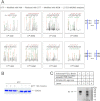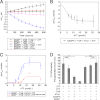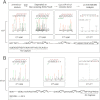Thioredoxin and thioredoxin reductase control tissue factor activity by thiol redox-dependent mechanism
- PMID: 23223577
- PMCID: PMC3561554
- DOI: 10.1074/jbc.M112.418046
Thioredoxin and thioredoxin reductase control tissue factor activity by thiol redox-dependent mechanism
Abstract
Abnormally enhanced tissue factor (TF) activity is related to increased thrombosis risk in which oxidative stress plays a critical role. Human cytosolic thioredoxin (hTrx1) and thioredoxin reductase (TrxR), also secreted into circulation, have the power to protect against oxidative stress. However, the relationship between hTrx1/TrxR and TF remains unknown. Here we show reversible association of hTrx1 with TF in human serum and plasma samples. The association is dependent on hTrx1-Cys-73 that bridges TF-Cys-209 via a disulfide bond. hTrx1-Cys-73 is absolutely required for hTrx1 to interfere with FVIIa binding to purified and cell-surface TF, consequently suppressing TF-dependent procoagulant activity and proteinase-activated receptor-2 activation. Moreover, hTrx1/TrxR plays an important role in sensing the alterations of NADPH/NADP(+) states and transducing this redox-sensitive signal into changes in TF activity. With NADPH, hTrx1/TrxR readily facilitates the reduction of TF, causing a decrease in TF activity, whereas with NADP(+), hTrx1/TrxR promotes the oxidation of TF, leading to an increase in TF activity. By comparison, TF is more likely to favor the reduction by hTrx1-TrxR-NADPH. This reversible reduction-oxidation reaction occurs in the TF extracellular domain that contains partially opened Cys-49/-57 and Cys-186/-209 disulfide bonds. The cell-surface TF procoagulant activity is significantly increased after hTrx1-knockdown. The response of cell-surface TF procoagulant activity to H(2)O(2) is efficiently suppressed through elevating cellular TrxR activity via selenium supplementation. Our data provide a novel mechanism for redox regulation of TF activity. By modifying Cys residues or regulating Cys redox states in TF extracellular domain, hTrx1/TrxR function as a safeguard against inappropriate TF activity.
Figures








Similar articles
-
Mechanistic insights into the inhibitory effects of palmitoylation on cytosolic thioredoxin reductase and thioredoxin.Biochimie. 2015 Mar;110:25-35. doi: 10.1016/j.biochi.2014.12.018. Epub 2015 Jan 8. Biochimie. 2015. PMID: 25576832
-
A thioredoxin reductase and/or thioredoxin system-based mechanism for antioxidant effects of ambroxol.Biochimie. 2014 Feb;97:92-103. doi: 10.1016/j.biochi.2013.09.024. Epub 2013 Oct 5. Biochimie. 2014. PMID: 24103200
-
Molecular bases of thioredoxin and thioredoxin reductase-mediated prooxidant actions of (-)-epigallocatechin-3-gallate.Free Radic Biol Med. 2010 Dec 15;49(12):2010-8. doi: 10.1016/j.freeradbiomed.2010.09.031. Epub 2010 Oct 14. Free Radic Biol Med. 2010. PMID: 20951799
-
Tissue factor de-encryption, thrombus formation, and thiol-disulfide exchange.Semin Thromb Hemost. 2013 Feb;39(1):40-7. doi: 10.1055/s-0032-1333311. Epub 2013 Jan 16. Semin Thromb Hemost. 2013. PMID: 23325480 Review.
-
Thioredoxin reductase as a pharmacological target.Pharmacol Res. 2021 Dec;174:105854. doi: 10.1016/j.phrs.2021.105854. Epub 2021 Aug 27. Pharmacol Res. 2021. PMID: 34455077 Review.
Cited by
-
Tissue Factor Prothrombotic Activity Is Regulated by Integrin-arf6 Trafficking.Arterioscler Thromb Vasc Biol. 2017 Jul;37(7):1323-1331. doi: 10.1161/ATVBAHA.117.309315. Epub 2017 May 11. Arterioscler Thromb Vasc Biol. 2017. PMID: 28495929 Free PMC article.
-
Diet supplementation with DHA-enriched food in football players during training season enhances the mitochondrial antioxidant capabilities in blood mononuclear cells.Eur J Nutr. 2015 Feb;54(1):35-49. doi: 10.1007/s00394-014-0683-2. Epub 2014 Mar 19. Eur J Nutr. 2015. PMID: 24643755 Clinical Trial.
-
Tissue factor in cancer-associated thromboembolism: possible mechanisms and clinical applications.Br J Cancer. 2022 Dec;127(12):2099-2107. doi: 10.1038/s41416-022-01968-3. Epub 2022 Sep 12. Br J Cancer. 2022. PMID: 36097177 Free PMC article. Review.
-
Protein disulfide isomerase in thrombosis and vascular inflammation.J Thromb Haemost. 2013 Dec;11(12):2084-91. doi: 10.1111/jth.12413. J Thromb Haemost. 2013. PMID: 24118938 Free PMC article. Review.
-
Role of Cell Surface Lipids and Thiol-Disulphide Exchange Pathways in Regulating the Encryption and Decryption of Tissue Factor.Thromb Haemost. 2019 Jun;119(6):860-870. doi: 10.1055/s-0039-1681102. Epub 2019 Mar 12. Thromb Haemost. 2019. PMID: 30861549 Free PMC article. Review.
References
-
- Cimmino G., Golino P., Badimon J. J. (2011) Pathophysiological role of blood-borne tissue factor. Should the old paradigm be revisited? Intern. Emerg. Med. 6, 29–34 - PubMed
-
- Belting M., Ahamed J., Ruf W. (2005) Signaling of the tissue factor coagulation pathway in angiogenesis and cancer. Arterioscler. Thromb. Vasc. Biol. 25, 1545–1550 - PubMed
Publication types
MeSH terms
Substances
LinkOut - more resources
Full Text Sources
Other Literature Sources
Miscellaneous

